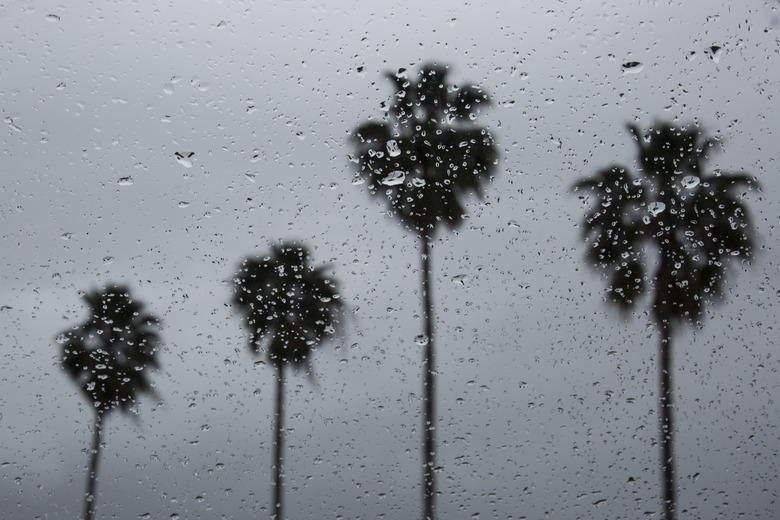California Could Be In For A Once-In-A-Millennium Rainstorm – Here's What You Need To Know
When you think of California's climate woes over the past few years, one of two words probably come to mind: wildfires, or drought.
And it's true: For years, California has been dealing with recurring drought conditions that have threatened the food supply (which is why you may have seen so many articles about why water-intensive crops, like almonds, were in danger). And, thanks to the dry conditions, California has also struggled with raging wildfires, including last November's Camp Fire, which was one of the most destructive in the state's history.
Now, sadly, California is facing a new kind of climate challenge: a mega-storm, which experts call an ARkStorm, that threatens to pummel the state with "rain of Biblical proportions," according to the Los Angeles Times.
So What is an ARkStorm, Anyway?
So What is an ARkStorm, Anyway?
Let's start with the basics: ARkStorm stands for "Atmospheric River 1,000 Storm." An ARkStorm is a hypothetical scenario that climate experts came up with to describe an extreme rainstorm. Specifically, an ARkStorm scenario involves a storm so extreme that it would involve rain levels exceeding what would happen an average of once every 500 to 1,000 years.
And, unfortunately, an ARkStorm could be headed this way. As the Los Angeles Times reports, the Golden State may be in for ARkStorm conditions, which means weeks of pummeling rain and widespread flooding. We're talking up to 10 feet of rain in one month – definitely not your average rainstorm.
What Happens When an ARkStorm hits California?
What Happens When an ARkStorm hits California?
ARkStorms are so rare that scientists have to use hypothetical modeling to understand what might happen if one hit today. But we know it likely involves a lot of flooding.
While California does have a flood protection system, it's generally equipped to deal with once-in-100- or -200-year flooding. Not the type of storm that could happen once in a millennium – and certainly not to deal with up to 10 feet of rain in a short period of time.
The U.S. Geological Survey's report on ARkStorm Scenarios notes that an ARkStorm would cause flooding all along California's coast. Some of the worst flooding would happen in Orange County, San Diego, the San Francisco Bay Area, as well as Los Angeles County.
The last time an ARkStorm happened in California – all the way back in 1861 – Los Angeles county saw a staggering 66 inches of rain fall over a 43-day period. Large regions of Central and Southern California stayed underwater for six months, and even neighboring states like Oregon, Nevada, Arizona and Utah saw flooding.
It was also disastrous for California's economy at the time. The flood wiped out one-quarter of California's economic activity, and ultimately drove the state into bankruptcy.
The Coming ARkStorm Could be Even Worse
The Coming ARkStorm Could be Even Worse
Although scientists aren't yet sure how severe the storm could be, they do know it's likely to be devastating for the state. Some areas of Los Angeles County – like Pico Rivera, located about 11 miles out of downtown L.A. – could be buried under 20 feet of water if the nearby dams fail, the Los Angeles Times reports.
Overall, flooding from storm is estimated to displace a staggering 1.5 million people in California, and cost more than $725 billion in structural damage and lost economic activity.
How Does Climate Change Affect ARkStorms?
How Does Climate Change Affect ARkStorms?
While an ARkStorm scenario is still a theoretical one – which means we don't know exactly how much it's tied to climate change – scientists do know that climate change has impacted precipitation levels in California.
In general, climate change has made the amount of precipitation more extreme. That means that dry years are drier – which explains the widespread droughts. But it also means the state can "whiplash" to extremely wet weather – so extreme that the weather could count as an ARkStorm.
And, as UCLA climate scientists tells the Los Angeles Times, extreme weather events like ARkStorms could happen more often than scientists previously thought.
"A newer study suggests the chances of seeing another flood of that magnitude over the next 40 years are about 50-50," a UCLA climate scientist Daniel Swain said.
So how can you help? Get involved in your local, state and federal politics. Fight for investment in infrastructure to protect against flooding – like funding to improve dams in your state – and a comprehensive plan to combat climate change to help nip (some) extreme weather events in the bud.
References
- U.S. Geological Survey: Overview of the ARkStorm Scenario
- Los Angeles Times: Rare L.A. mega-storm could overwhelm dam and flood dozens of cities, experts say
- The Climate Reality Project: How Climate Change is Affecting California
- The Oregonian: California now worries about massive 'ARkStorm' flood, which could devastate Oregon too
- Scientific American: California Megaflood: Lessons from a Forgotten Catastrophe
Cite This Article
MLA
Tremblay, Sylvie. "California Could Be In For A Once-In-A-Millennium Rainstorm – Here's What You Need To Know" sciencing.com, https://www.sciencing.com/california-could-be-in-for-a-once-in-a-millennium-rainstorm-heres-what-you-need-to-know-13717331/. 21 February 2019.
APA
Tremblay, Sylvie. (2019, February 21). California Could Be In For A Once-In-A-Millennium Rainstorm – Here's What You Need To Know. sciencing.com. Retrieved from https://www.sciencing.com/california-could-be-in-for-a-once-in-a-millennium-rainstorm-heres-what-you-need-to-know-13717331/
Chicago
Tremblay, Sylvie. California Could Be In For A Once-In-A-Millennium Rainstorm – Here's What You Need To Know last modified March 24, 2022. https://www.sciencing.com/california-could-be-in-for-a-once-in-a-millennium-rainstorm-heres-what-you-need-to-know-13717331/
